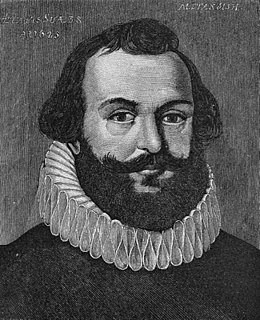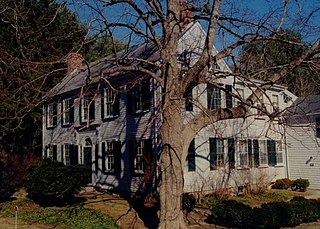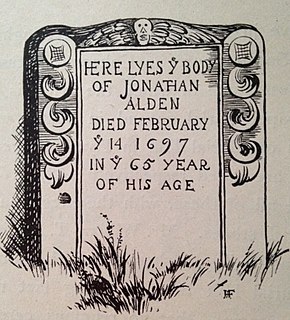
Capt. John Alden Sr. was a crew member on the historic 1620 voyage of the Pilgrim ship Mayflower. Rather than return to England with the ship, he stayed at what became Plymouth Colony. He was hired in Southampton, England, as the ship's cooper, responsible for maintaining the ship's barrels. He was a signatory to the Mayflower Compact. He married fellow Mayflower passenger Priscilla Mullins, whose entire family perished in the first winter.

Myles Standish was an English military officer hired by the Pilgrims as military adviser for Plymouth Colony. He accompanied them on the Mayflower journey and played a leading role in the administration and defense of Plymouth Colony from its inception. On February 17, 1621, the Plymouth Colony militia elected him as its first commander and continued to re-elect him to that position for the remainder of his life. He served as an agent of Plymouth Colony in England, as assistant governor, and as treasurer of the Colony. He was also one of the first settlers and founders of the town of Duxbury, Massachusetts.

Peleg Wadsworth was an American officer during the American Revolutionary War and a Congressman from Massachusetts representing the District of Maine. He was also grandfather of noted American poet Henry Wadsworth Longfellow.

The King Caesar House is a historic house located at 120 King Caesar Road, Duxbury, Massachusetts. It is operated as a non-profit museum by the Duxbury Rural and Historical Society.

Edward Hutchinson Robbins was an American lawyer and politician who served as the sixth Lieutenant Governor of Massachusetts from 1802 to 1806.

Headquarters House, also known as the William Hickling Prescott House, is an historic house museum located at 55 Beacon Street on Beacon Hill in Boston, Massachusetts. It is the left-hand portion of a double townhouse at 54–55 Beacon Street, seen in the photograph. The townhouse, built in 1808 to a design by Asher Benjamin, was designated a National Historic Landmark in 1964 for its association with William Hickling Prescott (1796–1859), one of the nation's first historians. The house is now a museum operated by the Massachusetts chapter of the National Society of the Colonial Dames of America, which purchased it for its headquarters in 1944.

The Captain Daniel Bradford House is an historic house at 251 Harrison Street in Duxbury, Massachusetts. The 2-1/2 story wood frame house was built in 1808 by Captaian Daniel Bradford, on land belonging to his father, Colonel Gamaliel Bradford. It is five bays wide and three deep, with a hip roof and large central chimney. The front entry is flanked by sidelight windows and pilasters, above which are a fanlight and a gable. A two-story ell is attached to the right side of the house.

The Capt. Gamaliel Bradford House is an historic house at 942 Tremont Street in Duxbury, Massachusetts. Built in 1807, the house is locally distinctive for its brick side walls and monitor section above the hip roof. It was listed on the National Register of Historic Places in 1978.

The Capt. Gershom Bradford House is an historic house at 931 Tremont Street in Duxbury, Massachusetts. The two-story wood frame house was built in 1807 by Captain Gershom Bradford. The main block has a side-gable roof, and is five bays wide and two deep. A two-story ell attached to the right rear connects the house to another addition, a replacement for a barn torn down c. 1900. The house is now owned and operated by the Duxbury Rural and Historical Society as a historic house museum, and has been decorated with original Bradford family furnishings to appear as it did during the 1840s.

The Myles Standish Burial Ground in Duxbury, Massachusetts is, according to the American Cemetery Association, the oldest maintained cemetery in the United States.
Reverend Ichabod Wiswall (1637–1700) was the third pastor of the church in Duxbury, Plymouth Colony, British America. Though he is thought to have given the first known funeral sermon in British America at the burial of Capt. Jonathan Alden in 1697, American funeral sermons predate this event by several decades.

Capt. John Jeffries Burial Marker is an historic burial monument in the cemetery at Scullville Bible Church in Egg Harbor Township, New Jersey, along County Route 559 near Somers Point. It was built in 1887 and added to both the New Jersey Register of Historic Places and the National Register of Historic Places in 1984.

Rufus Hathaway (1770–1822) was an American physician and folk art painter. He lived in southern Massachusetts, where he painted numerous portraits between 1790 and 1795. He later studied medicine and established himself as a doctor at Duxbury.

Ezra Weston II, also known as King Caesar, was a prominent shipbuilder and merchant who operated a large maritime industry based in Duxbury and Boston, Massachusetts. His father, Ezra Weston I, began small scale shipbuilding operations in Duxbury in 1763 and eventually came to be known as "King Caesar" for his success in business. Ezra Weston II, his only son, inherited the nickname when Ezra I died in 1822.

Capt. Jonathan Alden Sr., the son of Mayflower immigrants, was a military officer and farm owner in Plymouth Colony. The home he built in the late 1600s is now a National Historic Landmark in Duxbury, Massachusetts.





























